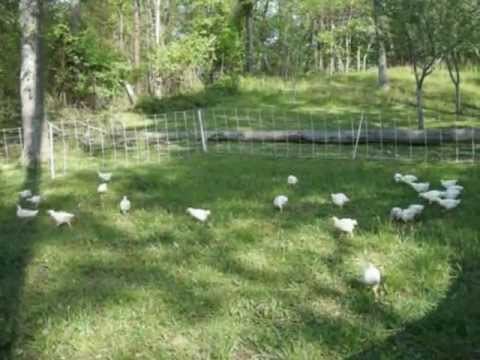I free range 100% of the time and control feed quite strictly. Those pics are from one of my birds. It is possible in free-range birds because their genetics lean them toward it, their level of activity itself can cause it, even if they build the right muscles, they can and do get it. One of mine evidently did.  it takes time for the green to turn, it isn't processing or inhumane treatment in the moments or hours before slaughter... From my research it happens at least a day, usually many days before they are butchered. Before then it is just a red or purplish tinge to the meat, from burst blood vessels in muscle that just can't support activity. The green happens when the blood supply is gone and the muscle dies. I just thought I'd throw it out there just in case, it sure grossed me out, and I thought you might want to be prepared if per chance a customer got one. There was NO sign of it when we butchered or cooked it, just when we boned out the carcass after roasting.
it takes time for the green to turn, it isn't processing or inhumane treatment in the moments or hours before slaughter... From my research it happens at least a day, usually many days before they are butchered. Before then it is just a red or purplish tinge to the meat, from burst blood vessels in muscle that just can't support activity. The green happens when the blood supply is gone and the muscle dies. I just thought I'd throw it out there just in case, it sure grossed me out, and I thought you might want to be prepared if per chance a customer got one. There was NO sign of it when we butchered or cooked it, just when we boned out the carcass after roasting.
 it takes time for the green to turn, it isn't processing or inhumane treatment in the moments or hours before slaughter... From my research it happens at least a day, usually many days before they are butchered. Before then it is just a red or purplish tinge to the meat, from burst blood vessels in muscle that just can't support activity. The green happens when the blood supply is gone and the muscle dies. I just thought I'd throw it out there just in case, it sure grossed me out, and I thought you might want to be prepared if per chance a customer got one. There was NO sign of it when we butchered or cooked it, just when we boned out the carcass after roasting.
it takes time for the green to turn, it isn't processing or inhumane treatment in the moments or hours before slaughter... From my research it happens at least a day, usually many days before they are butchered. Before then it is just a red or purplish tinge to the meat, from burst blood vessels in muscle that just can't support activity. The green happens when the blood supply is gone and the muscle dies. I just thought I'd throw it out there just in case, it sure grossed me out, and I thought you might want to be prepared if per chance a customer got one. There was NO sign of it when we butchered or cooked it, just when we boned out the carcass after roasting.
Last edited:



